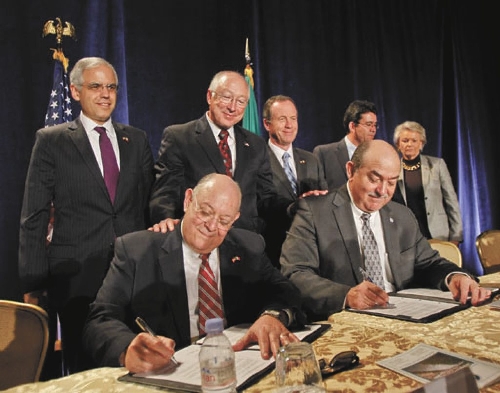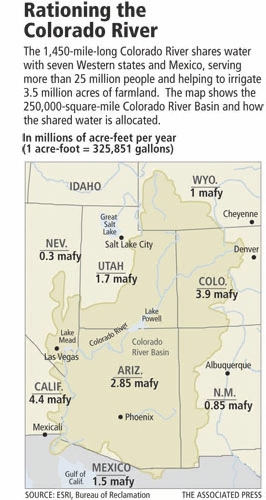Lake Mead will benefit from accord
CORONADO, Calif. - The United States and Mexico agreed Tuesday to rewrite rules on sharing water from the Colorado River, capping a five-year effort to create a united front against future droughts.
The far-reaching agreement signed near San Diego gives Mexico badly needed storage capacity by granting rights to leave some of its river water in Lake Mead.
Mexico will forfeit some of its share of the river during shortages, bringing itself in line with western U.S. states that already have agreed how much they give up in dry years.
Water agencies in California, Arizona and Nevada also will buy water from Mexico, which will use some of the money to upgrade its infrastructure.
U.S. Interior Secretary Ken Salazar called the agreement the most important international accord on the Colorado River since a 1944 treaty.
"We have chosen cooperation and consensus over discord," he said.
The agreement, coming in the final days of the administration of Mexican President Felipe Calderon, is a major amendment to the 1944 treaty considered sacred by many south of the border. The treaty grants Mexico 1.5 million acre-feet of river water each year - enough to supply about 3 million homes - making it the lifeblood of Tijuana and other cities in northwest Mexico.
Mexico will surrender some of its allotment when the water level in Lake Mead drops to 1,075 feet and reap some of the surplus when it rises to 1,145 feet, according to a summary of the agreement prepared by the Metropolitan Water District of Southern California, which will buy some of Mexico's water. As of Nov. 1, the lake's surface was at 1,116.5 feet, well short of the maximum elevation of 1,221.4 feet.
The agreement expires in five years and is being billed as a trial run, potentially making it more palatable in Mexico.
"These are big political steps for Mexico to take," said Jeffrey Kightlinger, Metropolitan's general manager. "Chances are we won't have a surplus and we won't have a shortage but, if we do, we'll have the guidelines in place on how we're going to handle it."
In 2007, facing an eight-year drought, California, Arizona and Nevada agreed on how much each state should sacrifice during shortages on the 1,450-mile river, which flows from the Rocky Mountains to Mexico. That same year, the United States and Mexico promised to work on ways to address shortages.
The negotiations gained a sense of urgency for Mexico in 2010 after a magnitude-7.2 earthquake damaged canals and other infrastructure, forcing it to store water temporarily in Lake Mead.
"They have some storage, but it's not enough for drought and emergencies," said Halla Razak, Colorado River program director at the San Diego County Water Authority.
Roberto Salmon, Mexico's representative to the International Boundary and Water Commission, said the pact was the latest sign of improved cooperation with the United States.
The Colorado River is also a key source of water for Colorado, New Mexico, Utah and Wyoming.
Under the pact, Mexico could leave as much as 1.5 million acre-feet of water in Lake Mead over five years.
That is enough water to raise the lake's surface by as much as 15 feet and offer some protection for the intake pipes through which the Las Vegas Valley draws 90 percent of its drinking water.
Nevada also stands to gain some water through the international agreement.
In exchange for a $2.5 million investment in infrastructure south of the border, the Southern Nevada Water Authority gets a one-time share of 23,700 acre-feet from the savings Mexico expects to see by lining irrigation canals and upgrading irrigation methods.
One acre-foot is enough water to supply two average Las Vegas homes for one year.
The $2.5 million would be paid to Mexico over three years starting in 2014. The authority would have until 2036 to draw on the 23,700 acre-feet.
Review-Journal writer Henry Brean contributed to this report.
Timeline of key Colorado River water use events:
- Summer 1869: John Wesley Powell's expedition explores the Colorado River and Grand Canyon by boat.
- 1889: International Boundary and Water Commission created.
- Nov. 24, 1922: Colorado River Compact signed. "The Law of the River" outlines the rights of northern and southern basins to each use 7.5 million acre feet of water a year. An acre-foot is about enough to serve two homes annually.
- 1928: Boulder Canyon Project Act: Ratifies 1922 compact; authorizes Hoover Dam and lower basin irrigation facilities. California apportioned 4.4 million acre-feet of water a year; Arizona, 2.8 million; Nevada 300,000.
- Sept. 30, 1935: Boulder Dam dedication. Later renamed Hoover Dam
- Feb. 3, 1944: Treaty for the Utilization of Waters of the Colorado and Tijuana Rivers and of the Rio Grande: U.S. commits 1.5 million acre-feet of Colorado River water annually to Mexico.
- 1948: Upper Colorado River Basin Compact: Apportions 7.5 million acre-feet of upper basin water a year. Colorado gets 51.75 percent; Utah, 23 percent; Wyoming, 14 percent; New Mexico, 11.25 percent. Arizona also gets 50,000 acre-feet of upper basin water annually.
- 1956: Colorado River Storage Project Act: Authorizes construction of Glen Canyon, Flaming Gorge, Navajo and Curecanti dams.
- 1973: Minute 242 of the U.S.-Mexico International Boundary and Water Commission: U.S. must reduce salinity of water delivered to Mexico.
- 1974: Colorado River Basin Salinity Control Act: Authorizes desalting and salinity control projects including the Yuma Desalting Plant.
- 2010: Magnitude-7.2 Easter Sunday earthquake damages Mexico irrigation systems, prompts temporary Lake Mead water storage agreement.
- Nov. 20, 2012: Minute 319 of the U.S.-Mexico International Boundary and Water Commission signing in California.
Source: U.S. Bureau of Reclamation, AP research.


















